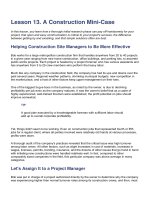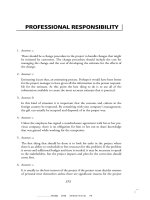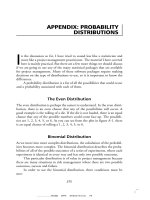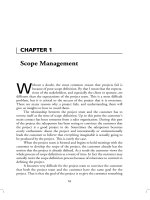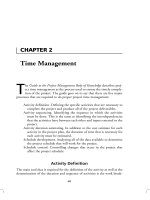Project Management Professional-Chapter 21
Bạn đang xem bản rút gọn của tài liệu. Xem và tải ngay bản đầy đủ của tài liệu tại đây (179.81 KB, 30 trang )
.......................... 9618$$ APPX 09-06-02 15:01:42 PS
This Page Intentionally Left Blank
TEAMFLY
Team-Fly
®
GLOSSARY
AC. Actual Cost. See Actual cost.
Accountability matrix. A structure that relates the project organization
structure to the work breakdown structure to help ensure that each
element of the project’s scope of work is assigned to a responsible indi-
vidual.
Activity. A unit of work performed as part of a project. An activity usually
has a duration, a cost, and resource requirements. Activities can then
be subdivided into tasks.
Activity definition. Identifying the specific activities that must be per-
formed in order to produce the various project deliverables.
Activity duration estimating. Estimating the number of work periods
that will be needed to complete individual activities.
Actual cost. In the earned value reporting system, this is the amount of
cost accumulated by doing work on the project. Only work done on
the project should be included in actual cost. Formerly, ACWP, Actual
Cost of Work Performed.
ACWP. Actual Cost of Work Performed. The actual cost that was incurred
to complete the work that was actually performed during a given time
period. The Guide to the PMBOK 2000 has changed this term to AC,
Actual Cost.
AD. Activity Description. A label used in a network diagram. The activity
description normally describes the scope of work of the activity.
ADM. Arrow Diagramming Method. A network diagramming technique
in which activities are represented by arrows. The tail of the arrow
represents the start and the head represents the finish of the activity
(the length of the arrow does not represent the expected duration of
the activity). Activities are connected at points called nodes (usually
drawn as small circles) to illustrate the sequence.
Administrative closure. Generating, gathering, and disseminating infor-
mation to formalize project completion.
AF. Actual Finish date. The actual date that an activity or task was com-
pleted.
Analogous estimate. Using the actual cost of a previous, similar project as
383
.......................... 9618$$ GLOS 09-06-02 15:01:37 PS
384 Glossary
the basis for estimating the cost of the current project. It is frequently
used to estimate total project costs when there is a limited amount of
detailed information about the current project.
AOA. Activity On Arrow. A network diagramming technique in which
activities are represented by arrows. The tail of the arrow represents the
start and the head represents the finish of the activity (the length of the
arrow does not represent the expected duration of the activity). Activi-
ties are connected at points called nodes (usually drawn as small circles)
to illustrate the sequence.
AON. Activity On Node. A network diagramming technique in which
activities are represented by boxes (or nodes). Activities are linked by
precedence relations to show the sequence in which the activities are to
be performed.
Application area. A category of projects that have common elements not
present in all projects. Application areas are usually defined in terms of
either the product of the projects (i.e., similar technologies or industry
sectors) or the type of customer (e.g., internal versus external, govern-
ment versus commercial). Application areas often overlap.
AS. Actual Start date. The point in time that work actually started on an
activity.
As-of-date. The point in time that separates actual data from future data.
Sometimes called the data date.
BAC. Budget At Completion. The estimated total cost of a project when
it is completed.
Backward pass. The calculation of late finish dates and late start dates
for the uncompleted portions of all network activities. Determined by
working backwards through the network logic from the project’s end
date.
Bar chart. A graphic display of schedule-related information. In the typi-
cal bar chart, activities of other project elements are listed down the left
side of the chart, dates are shown across the top, and activity durations
are shown as date-placed horizontal bars.
Baseline. The original plan (for a project, a work package, or an activity),
plus or minus approved changes. Usually used with a modifier (e.g.,
cost baseline, schedule baseline, performance measurement baseline).
Baseline finish date. The point in time that work was scheduled to finish
on an activity. The scheduled finish date is normally within the range
of dates delimited by the early finish date and the late finish date.
Baseline start date. The point in time when work was scheduled to start
.......................... 9618$$ GLOS 09-06-02 15:01:39 PS
385Glossary
on an activity. The scheduled start date is normally within the range of
dates delimited by the early start date and the late start date.
BCWP. Budgeted Cost of Work Performed. The sum of the approved
cost estimates (including any overhead allocation) for activities (or por-
tions of activities) completed during a given period (usually project-to-
date). In the Guide to PMBOK 2000 this term has been changed to
EV, Earned Value.
BCWS. Budgeted Cost of Work Scheduled. The sum of the approved cost
estimates (including any overhead allocation) for activities (or portions
of activities) scheduled to be performed during a given period (usually
project-to-date). In the Guide to the PMBOK 2000, this term has been
changed to PV, Planned Value.
Budget estimate. An assessment of the likely quantitative result. Usually
applied to project costs and durations and should always include some
indication of accuracy (e.g., עx percent). Usually used with a modifier
(e.g., preliminary, conceptual, feasibility). Some application areas have
specific modifiers that imply particular accuracy ranges (e.g., order-of-
magnitude estimate, budget estimate, and definitive estimate in engi-
neering and construction projects).
Calendar unit. The smallest unit of time used in scheduling the project.
Calendar units are generally in hours, days, or weeks, but can also be
in shift or even in minutes. Used primarily in relation to project man-
agement software.
CCB. Change Control Board. A formally constituted group of stakehold-
ers responsible for approving or rejecting changes to the project base-
lines.
Change control. A collection of formal, documented procedures that de-
fines the steps by which official project documents may be changed.
Change in scope. Any change to the project scope. A scope change almost
always requires an adjustment to the project cost or schedule.
Chart of accounts. Any numbering system used to monitor project costs
by category (e.g., labor, supplies, materials). The project chart of ac-
counts is usually based upon the corporate chart of accounts of the
primary performing organization.
Charter. A document issued by senior management that provides the proj-
ect manager with the authority to apply organizational resources to
project activities.
Code of accounts. Any numbering system used to uniquely identify each
element of the work breakdown structure.
.......................... 9618$$ GLOS 09-06-02 15:01:39 PS
386 Glossary
Communications planning. Determining the information and commu-
nications needs of the project stakeholders: who needs what informa-
tion, when will they need it, and how it will be given to them.
Concurrent engineering. An approach to project staffing that, in its most
general form, calls for implementers to be involved in the design phase.
Constraint. A restriction or limitation set on the start or finish date of an
activity.
Contingencies. Plans and funding set aside to take care of anticipated,
identified risks.
Contingency allowance. A separately planned quantity used to allow for
future situations that may be planned for only in part (sometimes called
‘‘known unknowns’’). For example, rework is certain, the amount of
rework is not. Contingency allowance may involve cost, schedule, or
both. Contingency allowances are intended to reduce the impact of
missing cost or schedule objectives. Contingency allowances are nor-
mally included in the project’s cost and schedule baselines.
Contingency planning. The development of a management plan that
identifies alternative strategies to be used to ensure project success if
specified risk events occur.
Contingency reserve. A separately planned quantity used to allow for fur-
ture situations that may be planned for only in part (sometimes called
‘‘known unknowns’’). For example, rework is certain, the amount of
rework is not. Contingency reserves may involve cost, schedule, or
both. Contingency reserves are intended to reduce the impact of miss-
ing cost or schedule objectives. Contingency reserves are normally in-
cluded in the project’s cost and schedule baselines.
Contract. A contract is a mutually binding agreement that obligates the
seller to provide the specified product and obligates the buyer to pay
for it.
Contract administration. Managing the relationship with the seller.
Contract closeout. Completion and settlement of the contract, including
resolution of all outstanding items.
Control. The process of comparing actual performance with planned per-
formance, analyzing variances, evaluating possible alternatives, and tak-
ing appropriate corrective action as needed.
Control charts. Control charts are a graphic display of the results, over
time and against established control limits, of a process. They are used
to determine if the process is ‘‘in control’’ or in need of adjustment.
.......................... 9618$$ GLOS 09-06-02 15:01:40 PS
387Glossary
Corrective action. Changes made to bring expected future performance
of the project in line with the plan.
Cost. The money and resources required to complete an activity.
Cost budgeting. Allocating the cost estimates to individual project com-
ponents.
Cost control. Controlling changes to the project budget.
Cost estimating. Estimating the cost of the resources needed to complete
project activity.
Cost management. The system used to maintain effective financial con-
trol of a project throughout its life cycle.
Cost of quality. The costs incurred to ensure quality. The cost of quality
includes quality planning, quality control, quality assurance, and re-
work.
CPFF. Cost Plus Fixed Fee contract. A type of contract where the buyer
reimburses the seller for the seller’s allowable costs (defined by the con-
tract) plus a fixed amount of profit.
CPI. Cost Performance Index. The ratio of budgeted costs to actual costs
(EV/AC). CPI is often used to predict the magnitude of a possible cost
overrun using the following formula: Original cost estimate/CPIסPro-
ject cost at completion.
CPIF. Cost Plus Incentive Fee contract. A type of contract where the
buyer reimburses the seller for the seller’s allowable costs (defined by
the contract), and the seller earns a fee if the seller meets defined per-
formance criteria.
CPM. Critical Path Method. A network analysis technique used to predict
project duration by analyzing which sequence of activities (path) has
the least amount of float.
Crashing. Taking actions necessary to decrease the total project duration
after analyzing the options to determine how to get the maximum com-
pression for the least cost.
Critical activity. Any activity on a critical path. Most commonly deter-
mined by using the critical path method. Although some activities are
‘‘critical’’ in the dictionary sense without being on the critical path, this
meaning is seldom used in the project context.
Critical path. In a project network diagram, the series of activities that
determine the earliest completion of the project. The critical path will
generally change from time to time as activities are completed ahead of
or behind schedule. Although normally calculated for the entire project,
the critical path can also be determined for a milestone or subproject.
.......................... 9618$$ GLOS 09-06-02 15:01:40 PS
388 Glossary
The critical path is usually defined as those activities with float less than
or equal to a specified value, often zero.
Current finish date. The current estimate of the point in time when an
activity will be completed.
Current start date. The current estimate of the point in time when an
activity will begin.
CV. Cost Variance. The difference between the EV and the AC.
DD. Data Date. The point in time that separates actual data from future
data. Also called the as-of-date.
Definitive estimate. An assessment of the likely quantitative result. Usu-
ally applied to project costs and durations and should always include
some indication of accuracy (e.g., עx percent). Usually used with a
modifier (e.g., preliminary, conceptual, feasibility). Some application
areas have specific modifiers that imply particular accuracy ranges (e.g.,
order-of-magnitude estimate, budget estimate, and definitive estimate
in engineering and construction projects).
Deliverable. Any measurable, tangible, verifiable outcome, result, or item
that must be produced to complete a project or part of a project. Often
used more narrowly in reference to an external deliverable, which is a
deliverable that is subject to approval by the project sponsor or cus-
tomer.
Dependencies. In a project, the relationships between tasks. For example,
a task may not begin until another task is complete.
DU. Duration. The number of work periods (not including holidays or
other nonworking periods) required to complete an activity or other
project element. Usually expressed as workdays or work weeks. Some-
times incorrectly equated with elapsed time. Should not be confused
with effort.
Dummy activity. An activity with zero duration used to show a logical
relationship in the arrow diagramming method. Dummy activities are
used when logical relationships cannot be completely or correctly de-
scribed with regular activity arrows. Dummies are shown graphically as
a broken line headed by an arrow.
Duration compression. Shortening the project schedule without reducing
the project scope. Duration compression is not always possible and
often requires an increase in project cost.
EAC. Estimate At Completion. The expected total cost of an activity, a
group of activities, or the project when the defined scope of work has
been completed. Most techniques for forecasting EAC include some
.......................... 9618$$ GLOS 09-06-02 15:01:42 PS
389Glossary
adjustment of the original cost estimate based on project performance
to date. Often shown as: EAC ס Actuals-to-date ם ETC.
Earned value analysis. A method for measuring project performance. It
compares the amount of work that was planned with what was actually
accomplished to determine if cost and schedule performance is as
planned.
EF. Early Finish date. In the critical path method, the earliest possible
point in time on which the uncompleted portions of an activity (or
the project) can finish based on the network logic and any schedule
constraints. Early finish dates can change as the project progresses and
changes are made to the project plan.
Effort. The number of labor units necessary to complete an activity or
other project element. Effort is usually expressed in hours, days, or
weeks and should not be confused with duration.
ES. Early Start date. In the critical path method, the earliest possible point
in time on which an activity (or the project) can finish based on the
network logic and any schedule constraints. Early start dates can change
as the project progresses and changes are made to the project plan.
Estimate. An assessment of the likely quantitative result. Usually applied
to project costs and durations and should always include some indica-
tion of accuracy (e.g., עx percent). Usually used with a modifier (e.g.,
preliminary, conceptual, feasibility). Some application areas have spe-
cific modifiers that imply particular accuracy ranges (e.g., order-of-mag-
nitude estimate, budget estimate, and definitive estimate in engineering
and construction projects).
ETC. Estimate (or estimated) To Complete (or completion). The expected
additional cost needed to complete an activity, a group of activities, or
the project. Most techniques for forecasting ETC include some adjust-
ment to the original estimate based on project performance to date.
EV. Earned Value. A method for measuring project performance. It com-
pares the amount of work that was planned with what was actually
accomplished to determine if cost and schedule performance are as
planned.
Event-on-node. A network diagramming technique in which events are
represented by boxes (or nodes) connected by arrows to show the se-
quence in which the events are to occur.
Exception report. Document that includes only major variations from
plan (rather than all variations).
Expected monetary value. The product of an event’s probability of occur-
.......................... 9618$$ GLOS 09-06-02 15:01:43 PS
390 Glossary
rence and the gain or loss that will result. For example, if there is a 50
percent probability that it will rain, and rain will result in a $100 loss,
the expected monetary value of the rain event is $50 (.5 ן $100).
Fast tracking. Compressing the project schedule by overlapping activities
that would normally be done in sequence, such as design and construc-
tion.
FF. (1) Free Float. The amount of time an activity can be delayed without
delaying the early start of any immediately following activities. (2) Fin-
ish-to-Finish. A dependency between two activities, where one activity
must finish before the other activity can finish.
FFP. Firm Fixed Price contract. A type of contract where the buyer pays
the seller a set amount (defined by the contract) regardless of the seller’s
cost.
Finish date. A point in time associated with an activity’s completion. Usu-
ally qualified by one of the following: actual, planned, estimated, sched-
uled, early, late, baseline, target, or current.
Fixed price contract. A type of contract where the buyer pays the seller a
set amount (defined by the contract) regardless of the seller’s cost.
Float. The amount of time that an activity may be delayed from its early
start without delaying the project finish date. Float is a mathematical
calculation and can change as the project progresses and changes are
made to the project plan. Also called slack.
Forecast final cost. The expected total cost of an activity, a group of activi-
ties, or the project when the defined scope of work has been completed.
Same as Estimate At Completion (EAC). Most techniques for forecast-
ing final cost include some adjustment of the original cost estimate
based on project performance to date. Often shown as EAC ס Actuals-
to-date ם ETC.
Forward pass. The calculation of the early start and early finish dates for
the uncompleted portions of all network activities.
FPIF. Fixed Price Incentive Fee contract. A type of contract where the
buyer pays the seller a set amount (defined by the contract), and the
seller can earn an additional amount if the seller meets defined perform-
ance criteria.
FS. Finish-to-Start. The dependency between two activities where one ac-
tivity must finish before the other activity can start.
Functional manager. A manager responsible for activities in a specialized
department or function (e.g., engineering, manufacturing, marketing).
Functional organization. An organization structure in which staff are
.......................... 9618$$ GLOS 09-06-02 15:01:43 PS
391Glossary
grouped hierarchically by specialty (e.g., production, marketing, engi-
neering, and accounting at the top level, with engineering, further di-
vided into mechanical, electrical, and others).
Gantt chart. A graphic display of schedule-related information. In the typ-
ical bar chart, activities of other project elements are listed down the
left side of the chart, dates are shown across the top, and activity dura-
tions are shown as date-placed horizontal bars.
GERT. Graphical Evaluation and Review Technique. A network analysis
technique that allows for conditional and probabilistic treatment of
logical relationships (i.e., some activities may not be performed).
Grade. A category or rank used to distinguish items that have the same
functional use (e.g., ‘‘hammer’’) but do not share the same require-
ments for quality (e.g., different hammers may need to withstand dif-
ferent amounts of force).
Hammock. An aggregate or summary activity (a group of related activities
is shown as one and reported at a summary level). A hammock may or
may not have an internal sequence.
Hanger. An unintended break in a network path. Hangers are usually
caused by missing activities or missing logical relationships.
IFB. Invitation For Bid. Generally, this term is equivalent to request for
proposal. However, in some application areas it may have a narrower
or more specific meaning.
Information distribution. Making needed information available to proj-
ect stakeholders in a timely manner.
Initiation. Committing the organization to begin a project phase.
Integrated cost/schedule reporting. A method for measuring project per-
formance. It compares the amount of work that was planned with what
was actually accomplished to determine if cost and schedule perform-
ance is as planned.
Key event schedule. A summary-level schedule that identifies the major
activities and key milestones.
Lag. A modification of a logical relationship that directs a delay in the
successor task. For example, in a finish-to-start dependency with a ten-
day lag, the successor activity cannot start until ten days after the prede-
cessor has finished.
Lead. A modification of a logical relationship that allows an acceleration
of the successor task. For example, in a finish-to-start dependency with
a ten-day lead, the successor activity can start ten days before the prede-
cessor has finished.
.......................... 9618$$ GLOS 09-06-02 15:01:44 PS
392 Glossary
Leveling. Any form of network analysis in which scheduling decisions
(start and finish dates) are driven by resource management concerns
(e.g., limited resource availability or difficult-to-manage changes in re-
source levels).
LF. Late Finish date. In the critical path method, the latest possible point
in time that an activity may begin without delaying a specified mile-
stone (usually the project finish date).
Life cycle costing. The concept of including acquisition, operating, and
disposal costs when evaluating various alternatives.
Line manager. (1) The manager of any group that actually makes a prod-
uct or performs a service. (2) A functional manager.
Link. A dependency between two project activities or between a project
activity and a milestone.
LOE. Level Of Effort. Support-type activity (e.g., vendor or customer liai-
son) that does not readily lend itself to measurement of discrete accom-
plishment. It is generally characterized by a uniform rate of activity
over a specific period of time.
Logic. The collection of activity dependencies that make up a project net-
work diagram.
Logic diagram. Any schematic display of the logical relationships of proj-
ect activities. Always drawn from left to right to reflect project chronol-
ogy. Often incorrectly referred to as a ‘‘PERT chart.’’
Logical relationship. A dependency between two project activities, or be-
tween a project activity and a milestone.
Loop. A network path that passes the same node twice. Loops cannot be
analyzed using traditional network analysis techniques such as CPM
and PERT. Loops are allowed in GERT.
LS. Late State date. In the critical path method, the latest possible point in
time that an activity may begin without delaying a specified milestone
(usually a project finish date).
Management reserve. A separately planned quantity used to allow for fu-
ture situations that are impossible to predict (sometimes called ‘‘known
unknowns’’). Management reserves may involve cost or schedule. Man-
agement reserves are intended to reduce the risk of missing cost or
schedule objectives. Use of management reserve requires a change to
the project’s cost baseline.
Master schedule. A summary-level schedule that identifies the major ac-
tivities and key milestones.
.......................... 9618$$ GLOS 09-06-02 15:01:44 PS
TEAMFLY
Team-Fly
®
393Glossary
Mathematical analysis. The process of identifying early and late start and
finish dates for the uncompleted portions of project activities.
Matrix organization. Any organizational structure in which the project
manager shares responsibility with the functional managers for assign-
ing priorities and for directing the work of individuals assigned to the
project.
Milestone. A significant event in the project, usually completion of a
major deliverable.
Milestone schedule. A summary-level schedule that identifies the major
milestones.
Mitigation. Taking steps to lessen risk by lowering the probability of a risk
event’s occurrence or reducing its effect should it occur.
Monitoring. The capture, analysis, and reporting of project performance,
usually as compared to plan.
Monte Carlo analysis. A schedule risk assessment technique that performs
a project simulation many times in order to calculate a distribution of
likely results.
MPM. Modern Project Management. A term used to distinguish the cur-
rent broad range of project management (scope, cost, time, quality,
risk, etc.) from narrower, traditional use that focused on cost and time.
Near-critical activity. An activity that has low total float.
Network. Any schematic display of the logical relationships of project ac-
tivities. Always drawn from left to right to reflect project chronology.
Often incorrectly referred to as a ‘‘PERT chart.’’
Network analysis. The process of identifying early and late start and finish
dates for the uncompleted portions of project activities.
Network logic. The collection of activity dependencies that make up a
project network diagram.
Network path. Any continuous series of connected activities in a project
network diagram.
Node. One of the determining points of a network; a junction point
joined to some or all of the other dependency lines.
OBS. Organizational Breakdown Structure. A depiction of the project or-
ganization arranged so as to relate work packages to organizational
units.
Order of magnitude estimate. An assessment of the likely quantitative
result. Usually applied to project costs and durations and should always
include some indication of accuracy (e.g., ע x percent). Usually used
with a modifier (e.g., preliminary, conceptual, feasibility). Some appli-
.......................... 9618$$ GLOS 09-06-02 15:01:45 PS


